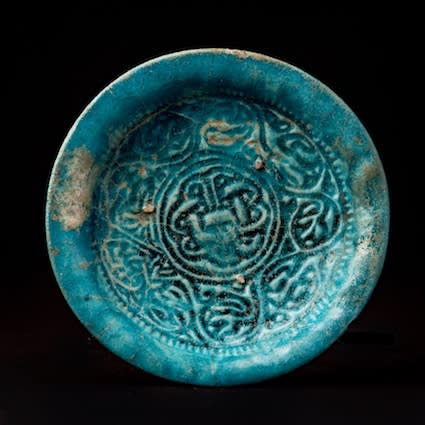Bamiyan Glazed Bowl, 1100 CE - 1300 CE
Glazed Earthenware
6 x 1.5
LK.152
These Turquoise glazed molded wares form a distinct group of pottery, unified by their fabric, shapes, techniques of making and decorating and their motifs. These wares are made in molds...
These Turquoise glazed molded wares form a distinct group of pottery, unified by their fabric, shapes, techniques of making and decorating and their motifs. These wares are made in molds many examples of which have been excavated at very well preserved sites complete with intact kilns. They show ornament in relief on the interior of small bowls. During the manufacturing process, the bowls were stacked on tripods which left distinctive scars on the inside of the bowls. The center of this bowl is decorated with an enlarged version of the same decoration that is repeated around the body of the bowl. This Bamiyan monochrome moulded pottery bowl has conical shape of rounded form on short feet, with a turquoise glaze, the moulding consisting of a central interlace motif and symmetrical designs around the interior.
According to the historian ‘Ala al-Din ‘Ata- Malik Juvayni d. 1283 AD the city of Bamiyan suffered great retribution in 1221-2 AD at the hands of the Mongol Emperor Chingiz Khan, because his favorite grandson Mutugen, son of Chaghatay was killed in that city. Chingiz Khan gave orders that every living creature should be killed and no prisoners be taken; and that henceforth no living creature should inhabit the place henceforth. Such a catastrophe might be good reason for the number of preserved pieces found from that area.
According to the historian ‘Ala al-Din ‘Ata- Malik Juvayni d. 1283 AD the city of Bamiyan suffered great retribution in 1221-2 AD at the hands of the Mongol Emperor Chingiz Khan, because his favorite grandson Mutugen, son of Chaghatay was killed in that city. Chingiz Khan gave orders that every living creature should be killed and no prisoners be taken; and that henceforth no living creature should inhabit the place henceforth. Such a catastrophe might be good reason for the number of preserved pieces found from that area.
